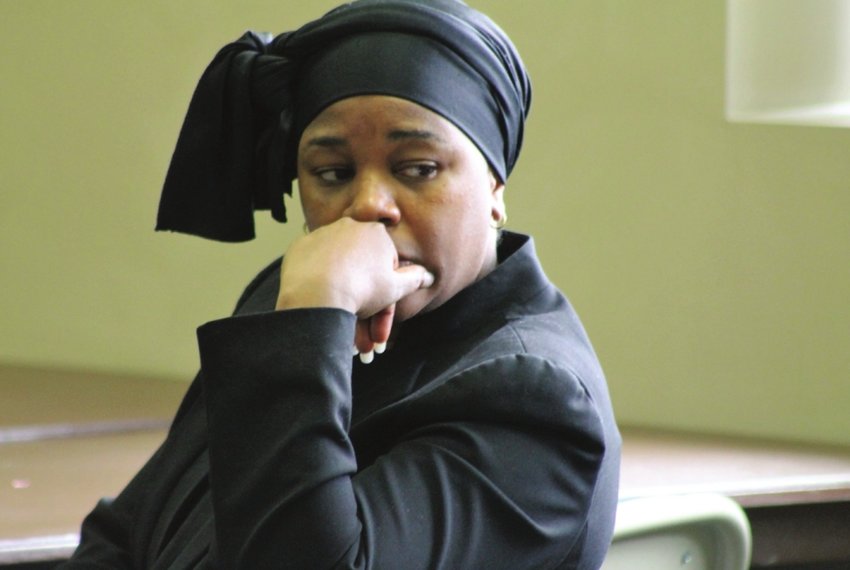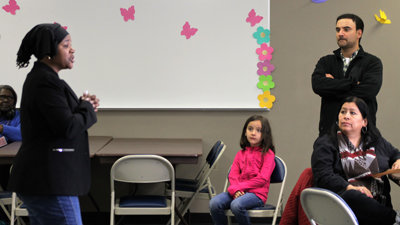
But neighborhood leaders throughout the city are skeptical. Why throw more taxpayer cash at studying the issues in neighborhoods, they wonder, when those answers already abound? Some say the move is a political move meant to shore up support for a 2017 re-election bid.
“Is he doing that to get their trust back because of all the bad things he has done at being the mayor?” asked a skeptical Melissa Jeffries, a neighborhood leader trying to revitalize the Coachlight Commons neighborhood on the City’s southwest side.
“I’m sorry I have to put that out there, but I think it’s just so he can get his name on that ballot and people will vote for him.”
Activists and political leaders pointed out that the city has brought in consultants and created study after study to identify neighborhood problems. The problems have all been identified — underutilized and underfunded neighborhood parks, crumbling infrastructure, a lack of community police officers and code compliance officials, absentee landlords and collapsing property values — but there has been no movement.
“We have had the studies and consultants,” said Melissa Quon Huber, a southside resident working to renew the former Lansing Neighborhood Council. “Why not just listen to the leaders and do something?”
Bernero dubbed his proposal Block by Block or B3 when he announced it on March 22.
“Working directly with our residents, we will take stock of each neighborhood’s assets and opportunities, as well as its challenges,” Bernero said. “Then we will collaboratively design a plan, whether it is focused on housing, walking and biking, crime prevention, beautification or other revitalization strategies. Together, we will create a tailor-made plan for every neighborhood in Lansing.”
It remains unclear how much money the administration is committing to the project, but it is highlighted by his 2016-2017 budget proposal. Efforts to get more information from the Bernero administration on the proposal were unsuccessful. Bernero’s media gatekeeper, Chief of Staff Randy Hannan, did not respond to questions emailed to him on Friday morning.
But neighborhood leaders said that the mayor’s plan is a tall order.
Leaders cite the city’s crumbling sidewalks, which also complicate efforts to clear them during winter weather, said Quon Huber. But they also point to a more important infrastructure to neighborhoods: The housing.
“Many of the homes have underwater mortgages,” said Quon Huber. Those underwater mortgages, combined with the 2008 housing bubble, have left many of the city’s neighborhoods struggling to confront abandoned and bank-owned properties.
The city, in partnership with the Ingham County Land Bank, has spent $30 million to tear down blighted properties throughout the city. And there are more buildings coming down, Eric Schertzing, the county treasurer who also chairs the Land Bank board, said.
Those plans include three properties in the Baker Donora Neighborhood. That’s a near southeast neighborhood bordered by the river on the north, Cedar Street on the west, Pennsylvania Avenue on the east and Mt. Hope Avenue on the south. The area has struggled, Betty Draher of the neighborhood group said.
But the removal of the blighted properties will help.
“It’s going to make a huge difference,” she said. “It’s a first step in making some changes in the Baker Donora Neighborhood.”
A step only, she notes. Her neighborhood, between Washington Avenue and Cedar Street, was spawned in the early 20th century by housing for REO plant workers. It even gave America Burt Reynolds, whose family lived on Donora Street when the actor’s father worked at the factory.
But those days are long gone, Draher admits.
“Seventy-five percent of our homes are rentals,” she said. “But the homeowners have been there for generations — second, third or fourth generation living in the same home. They’re committed.”
She said neighbors struggle with poverty, and absentee landlords fail to keep the property up. She notes the neighborhood has nearly 30 registered sex offenders within its borders. The reason, she’s been told, is the cheap rent. The state of Michigan will pay the first three months of rent for newly released prisoners.
The large number of rental properties combined with poor housing conditions make for a neighborhood population that is constantly in flux, she said. And it also creates a sense of hopelessness that translates to the youth acting out.
On the far southwest side of the city, in Coachlight Commons, the burgeoning rental market has also taken a toll. This neighborhood, longtime resident Gail Conyers said, used to be an affordable housing planned community funded and created under the 1960s administration of President Lyndon Johnson. She’s lived here since 1980. Originally she bought the house as a starter home. Her plan was to continue her work at the Michigan Department of Corrections, from which is now retired, and in 1985 sell the property and move to a new location. That never happened, she said, because the house had an underwater mortgage.
“So I just kept it, and built onto it, because I had the luxury of extra land,” she said.
Conyers said the neighborhood has been sold off to investors. In turn, the properties are being rented to immigrants. That causes potential cultural conflicts.
She speaks of her Hmong neighbors, who were renting the home next to her. The family put a hunting blind in a tree to take shots at deer and wild turkey in the park behind the homes.
“I had to explain to them that there was no hunting in the city,” she said. “I don’t care if there are deer and wild turkeys, you can’t do that in the city limits."
She laughs as she talks about the neighbor’s celebrations for their country’s anniversary, which involved live chickens. “Just keep them on your property,” she said with a chuckle.
“There’s no easy answer for Coachlight, and people just kind of mind their own business,” said Conyers. “It’s a different kind of neighborhood.”
That mind your own business attitude of the neighborhood was obvious Saturday afternoon at a classroom in the Alfreda Schmidt Southside Community Center. There, Jeffries and other neighbors were throwing a potluck party for the neighborhood located a few blocks away.
Turnout was scant. The handful included Jeffries, Maurice Allen, a fellow organizer, and Conyers, who only learned of the event via text message and while walking through the community center as part of an exercise regimen. Also attending were Adam Hussain, the Lansing city councilman for the area, and Norma Baltimore, who had recently moved back into the neighborhood to care for her aging mother.
On her way to the meeting, Jeffries said, she saw two people in Gerald W. Graves Park shooting up. The day before, she reported to Hussain, two young men were smoking marijuana in the park.
While the park has a basketball court and newer playground equipment, it’s still out of the way, tucked behind homes and bordered by empty lots. It’s become a magnet for trash and rubbish. On Saturday a black minifridge could be seen sitting in the fresh layer of snow.
Conyers noted that the first order of organizing Coachlight and doing any sort of assessment would be creating neighbor-to-neighbor connections. She said that’s difficult when a renter could be in the place one day, and the next all their belongings are out on the street. Until those human connections are made, overcoming the minor issues — code compliance for housing, trash and rubbish in the park, low-grade criminal activity — will be difficult.
Residents Saturday said they would like to see Graves Park become a beacon in the neighborhood. Plans are underway to host a party with free food and children’s activities in the near future.
That kind of park centered organizing has helped Baker-Donora, said Draher. It also helps that the park itself is sitting across the street from several owner-occupied homes.
It’s a front door park,” she said. “They know we are keeping on eye on it.”
As a result, she said, it’s “absolutely an anchor” for the neighborhood. “It’s a safe space,” she said.
{::PAGEBREAK::}
The city has focused on a form of policing called the broken window theory. That theory argues that when a neighborhood is seeing something as simple as a broken window on a home, that creates a perception that the area doesn’t matter. That in turn breeds more derelict buildings, trash, and minor criminal activity. Over time, those minor crimes escalate into major crime problems.

To battle this entropy, police use community policing options as well as rely on neighbors to call in when there are problems.
The security, crime and health problems (bedbugs, human feces in public spaces) at the Lansing Housing Commission’s high-rise housing project at 3200 S. Washington Ave. apartment building — in essence, a small, vertical neighborhood — is an example that has fallen into such a cycle. Last month, Lansing Police chief Michael Yankowski pleaded with residents to be the cops’ eyes and ears. Residents responded that they feared for their lives. He promised heavy police presence and ultimately a community policing officer.
But he told residents that extra policing won’t solve the problems on its own. It will take the involvement of all the residents. He and Lansing Housing Commission leaders said that improvements include addressing things like trash and human feces in the public spaces.
For Coachlight’s Allen, that approach may not work.
He argued a perception has been created about police because of the bad actions of a few. The result? “No one trusts them,” he said.
Leaders throughout the city confirmed that people are a key asset in revitalizing a neighborhood. They’re the ones living in the community, facing the issues of declining housing stock, crime, trash and other issues day in and day out. They also make up the core of the volunteers leading the revitalization efforts throughout the city.
Draher noted that its neighbors monitor the park, keeping it clean and preventing criminal activity. Elaine Womboldt, of Rejuvenating South Lansing, noted that neighbors in the southern part of the city fought for an ordinance to regulate charity donation bins — but they didn’t stop there and leave it for code enforcement to address. Residents regularly stop at overflowing charity bins and remove the trash, at their own expense.
“The people are absolutely our most important asset,” said Quon Huber. She’s working to revitalize the Lansing Neighborhood Council. The group was shut down in August 2014 after allegations of financial improprieties surfaced. A police investigation cleared the 34-yearold agency and its board and employees of any wrongdoing, but the funding the group had relied on was committed to an employee working inside City Hall and at Bernero’s direction.

Groups like the Neighborhood Council and Rejuvenating South Lansing are key in reading the tea leaves of redeveloping Lansing’s neighborhoods. They are connected with the leaders, formal and informal, in those neighborhoods that are able to provide clear, concise information about the needs and strengths of neighborhoods, they said.
But at the end of the day, fixing the problems in the neighborhoods will be a complex process. It’s taken decades for the problems to grow, and they have been exacerbated by the housing crisis, the Great Recession, and cuts in city services resulting from collapsed state revenue sharing and shrinking property values.
Jeffries said she is tired of Lansing “always being last,” and wants to know when the city will come together.
“Lansing is a puzzle and we are the pieces,” she said. “When are we going to put those pieces together to make something and to have something?”
Support City Pulse - Donate Today!
Comments
No comments on this item Please log in to comment by clicking here